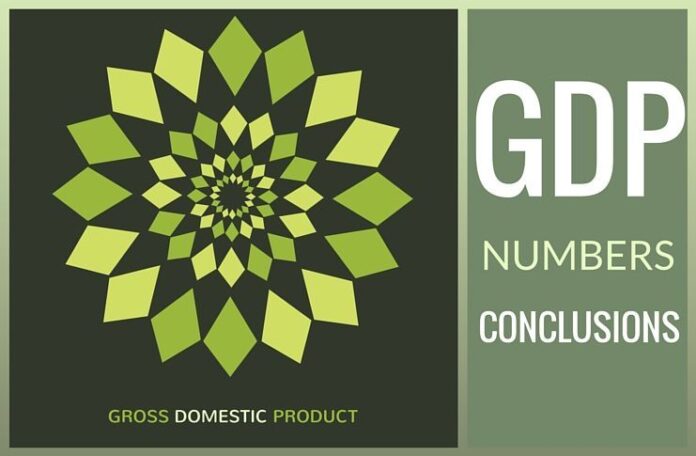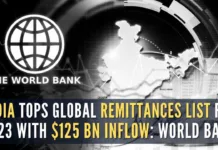
GDP (Gross Domestic Product) Numbers – Conclusion
This is Part 3 of our series on GDP. For Part 1, click here and for Part 2, click here.
[dropcap color=”#008040″ boxed=”yes” boxed_radius=”8px” class=”” id=””]T[/dropcap]his whole idea of quasi-corporate is not clear since an enterprise is corporate –under the corporate laws or partnership/ proprietorship under 1932 partnership act or under Income tax Act. Quasi-corporates are like partly pregnant.
We have given below in tables the relevant comparisons.
From Table – 2 we can infer that suddenly the role of households have come down mostly from tertiary sector where household only have 36% share compared to “corporates” who have 64%. Earlier “unorganised” sector—which is the proxy for the present household sector – had nearly 70 – 75% share in Tertiary sectors.
| Table – 1. Organised and unorganised share at current prices | |||||
| Year | Organised | Share (%) | Unorganized | Share (%) | Total |
| 2010-11 | 3248350 | 44.81 | 4000510 | 55.19 | 7248860 |
| 2011-12 | 3686032 | 43.92 | 4705659 | 56.08 | 8391691 |
| 2012-13 | 4197128 | 44.70 | 5191749 | 55.30 | 9388876 |
| Source: CSO:NAS | |||||
| Table – 2. Share of Corporate and Households on GVA | ||||||
| Industry | 2011-12 | 2013-14 | ||||
| Corporate | Household | Total | Corporate | Household | Total | |
| Primary | 16.1 | 83.9 | 100 | 15.1 | 84.5 | 100 |
| Secondary | 68.6 | 31.4 | 100 | 68.7 | 31.3 | 100 |
| Tertiary | 64.2 | 35.8 | 100 | 63.6 | 36.4 | 100 |
| Total | 55.1 | 44.9 | 100 | 55 | 45 | 100 |
| Source: CSO:NAS | ||||||
Looking at Tables 3 and 4 we find that share of tertiary sector has come down and that of manufacturing has gone up—due to statistical changes only.
| Table – 3. Gross Value added by broad sectors at 2004-05 prices | |||
| Industry | 2004-05 | 2011-12 | 2012-13 |
| Primary sector (Agriculture, Forestry & Fishing) | 19 | 17.9 | 17.5 |
| Secondary Sector (Mining. Manufacturing, electricity & construction) | 28 | 27.2 | 26.2 |
| Tertiary sector (Trade, hotel & restaurants, transport, storage & communication, financing, insurance, real estate & business servies, community, social & personal services and services etc.,) | 53 | 54.9 | 56.3 |
| Total | 100 | 100 | 100 |
| Source: CSO:NAS | |||
| Table – 4. Gross Value added by broad sectors at 2011-12 prices | |||
| Industry | 2011-12 | 2012-13 | 2013-14 |
| Primary Sector (Agriculture, Forestry & Fishing) | 21.6 | 21.1 | 20.8 |
| Secondary sector (Mining. Manufacturing, electricity & construction) | 29.9 | 28.9 | 27.9 |
| Tertiary sector (Trade, hotel & restaurants, transport, storage & communication, financing, insurance, real estate & business servies, community, social & personal services and services etc.,) | 48.5 | 50 | 51.3 |
| Total | 100 | 100 | 100 |
| Source: CSO:NAS | |||
[dropcap color=”#008040″ boxed=”yes” boxed_radius=”8px” class=”” id=””]T[/dropcap]he changes are mostly due to extensive usage of Ministry of Corporate affairs data on corporate and other quasi corporate using estimates.
Within Manufacturing itself if we compare the GVA of organised manufacturing[excluding quasi corporations of the unincorporated enterprises] of new series with GVA of registered manufacturing of old series for 2011-12 we find it was Rs.94 lakh crores ($1.37 trillion) which has increased due to changes in mechanics to Rs.127 lakh crores ($1.85 trillion) – an increase of 35%
[see table 20 in page 47 of changes in Methodology and Data sources in The New series of National accounts – Base year 2011-12 –CSO;MOSPI]
We find it difficult to understand that GVA of registered [namely organised] manufacturing for the year 2011/12 at factor cost for 2004/05 series and at basic prices for 2011/12 series can make a difference of 35% even if all changes are accommodated unless the role of corporate are very large in later series.
In the case of unorganised manufacturing the situation is reverse with the GVA coming down from Rs.35 lakh crore ($509 billion) to Rs 28 lakh crore ($407 billion) a fall of nearly 20%.
This whole things makes it appear that our economy is suddenly more corporate than before – which it is not.
[dropcap color=”#008040″ boxed=”yes” boxed_radius=”8px” class=”” id=””]T[/dropcap]he Gross value added by household sector for the year 2011-12 at factor cost for old series and basic prices for new series has fallen from Rs.47 lakh crores ($684 billion) to Rs.37 lakh crores ($538 billion) a fall of more than 21%.
The fall is severe in manufacturing at 49%; trade 59%; hotels and restaurants 42%; non-Railway transport 45% and other services by 54%.
One reason given is the usage of company data is more extensive in the new series compared to old series. Nearly 5.25 Lakh companies are used now. Whether it is pro-rate boosting of GVA– based on share capital or detailed analysis is not clear. The GVA of non-financial private corporate sector in 2011-12 series compared to using earlier series at 2004-05 has increased by 9.8%; most of the increase has come about in manufacturing 29%; non-Railway transport 70%. Interestingly in trade it has come down by 63% which is puzzling unless we assume quasi corporations have played a large role to boost it.
Conclusion:
[dropcap color=”#008040″ boxed=”yes” boxed_radius=”8px” class=”” id=””]W[/dropcap]e cannot say with confidence that the GDP estimate of 7.6% suggested is reliable in the absence of details regarding converting “unorganized sector” in to “organized” and creating a “quasi organized” sector. It is as if someone in MoSPI was told to put India’s data into bins that follow the G-7 model. This is really unfortunate because there is no need to do this window dressing as India can sustain itself well on the strength of its savings rates. Inclusion of unincorporated as corporate is puzzling more so inclusion of “unorganized financial enterprises” as belonging to Quasi corporations and hence “corporate sector”. Hence the growth rate could be much higher or lower and our “guesstimate” is it is lower towards 7%.
The methodology adopted by CSO in using the details of companies numbering more than 5 lakhs needs to be explicitly stated. Most of the companies are shell or dummy companies.
CSO should bring out a USER FRIENDLY—“Sources and Methods” guide book. But readability and simplicity should be the norm. The earlier versions are simply not user friendly and more confusing. In this CSO can look at and imitate US statistical service.
Many other economists Like R.Nagaraj of Indira Gandhi Institute of Development Research –Mumbai]; C.R John Member Planning Board –Kerala; Surjit Bhalla [Delhi based Economist] etc. have also raised concerns about Corporate inclusion and need to share raw data sources.
We have produced world renowned statisticians like P C Mahalonobis / C R Rao/ R C Bose etc. but our data base and explanations do not justify these experts.
[dropcap color=”#008040″ boxed=”yes” boxed_radius=”8px” class=”” id=””]T[/dropcap]he Ministry of Statistics and Programme Implementation is considered as a “punishment” posting for ministers and allotted to those who are neither knowledgeable about statistics nor understand the need for a good data base.
Government should constitute a commission independent of the current “experts” involved—to look into this whole issue of drastic revision and need for transparency.
In appointing such a commission Government needs to recognize that all experts in economics/Statistics are not available only in Delhi and all those in Delhi are not necessarily experts.
References:
-
Anindita Sinharay, Ashish Kumar & T C A Anant – Decoding the GVA growth rate –http://www.business-standard.com/article/opinion/anindita-sinharay-ashish-kumar-t-c-a-anant-decoding-the-gva-growth-rate-115072801461_1.html
-
Why 7.6% growth is hard to square – http://www.thehindu.com/opinion/lead/why-76-growth-is-hard-to-square/article8224204.ece [Prof R Nagaraj of IGDIR]
-
Let People Know Methods of GDP Growth Calculation – http://www.newindianexpress.com/magazine/voices/Let-People-Know-Methods-of-GDP-Growth-Calculation/2016/02/20/article3284525.ece [C.P John Member _Kerala state Planning Board]
-
India’s GDP growth seen accelerating to 7.6% in FY16 – http://www.livemint.com/Politics/nlmtj4uHBrrsf9IDGCCbsN/Indias-GDP-grows-at-73-in-December-quarter.html [Asit Rajan Mishra ]
-
No Proof Required: Believe it, GDP data is right – http://indianexpress.com/article/opinion/columns/no-proof-required-believe-it-gdp-data-is-right/#sthash.xMExDMY5.dpuf [Surjit Bhalla]
Note:
1. The conversion rate used in this article is 1 USD = 68.73 Rupees.
2. Text in Blue points to additional data on the topic.
- नकली खबर लक्षण है, बीमारी नहीं! - April 16, 2018
- Fake News/ Accreditation and Sedition - April 4, 2018
- Two Poisonous Seeds - March 15, 2018










